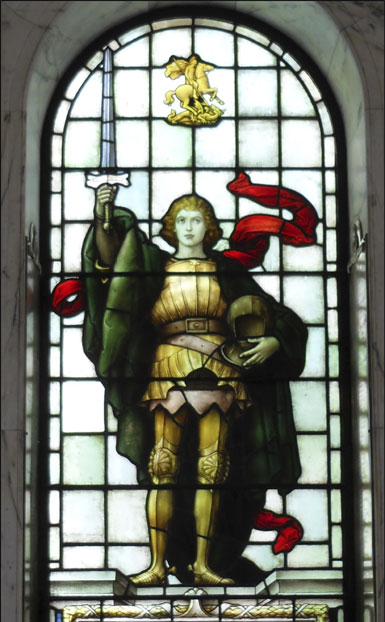Belfast City Hall
Memorial windows: World War I (left), World War II (right)
The year 1924 "saw the first reunion of the North Irish Horse, which was held in Thompson's Restaurant, Belfast on 28 February and at which it was agreed that a memorial to the Regiment's dead should be erected. a sum of 500 pounds 'had been allocated from certain funds for the purpose, and a committee had the matter in hands'. The memorial took the form of a window in Belfast City Hall and was unveiled and dedicated on 30 April 1925, on which day the second regimental reunion was held. ... There is a plaque on either side listing the names of the men who fell. A second memorial window, dedicated to those who fell in the Second World War, was installed beside this window and dedicated on 28 October 1962." (R. Doherty, The North Irish Horse: A Hundred years of Service, p.39.)


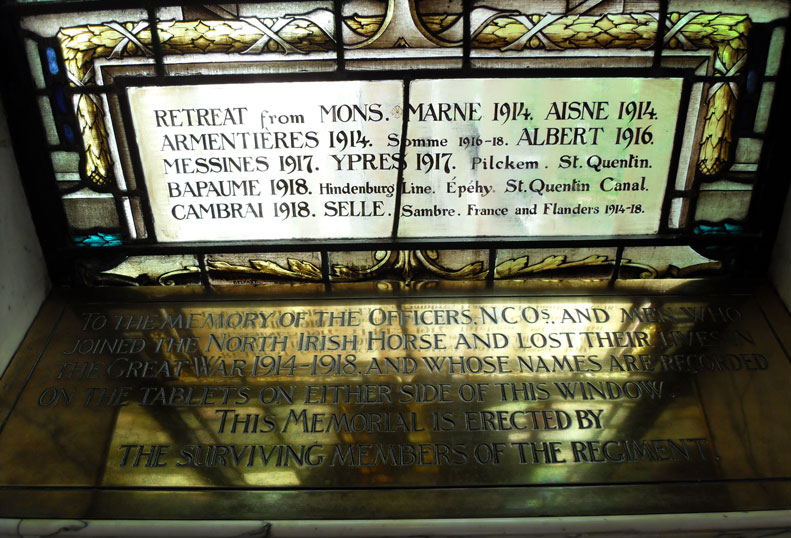
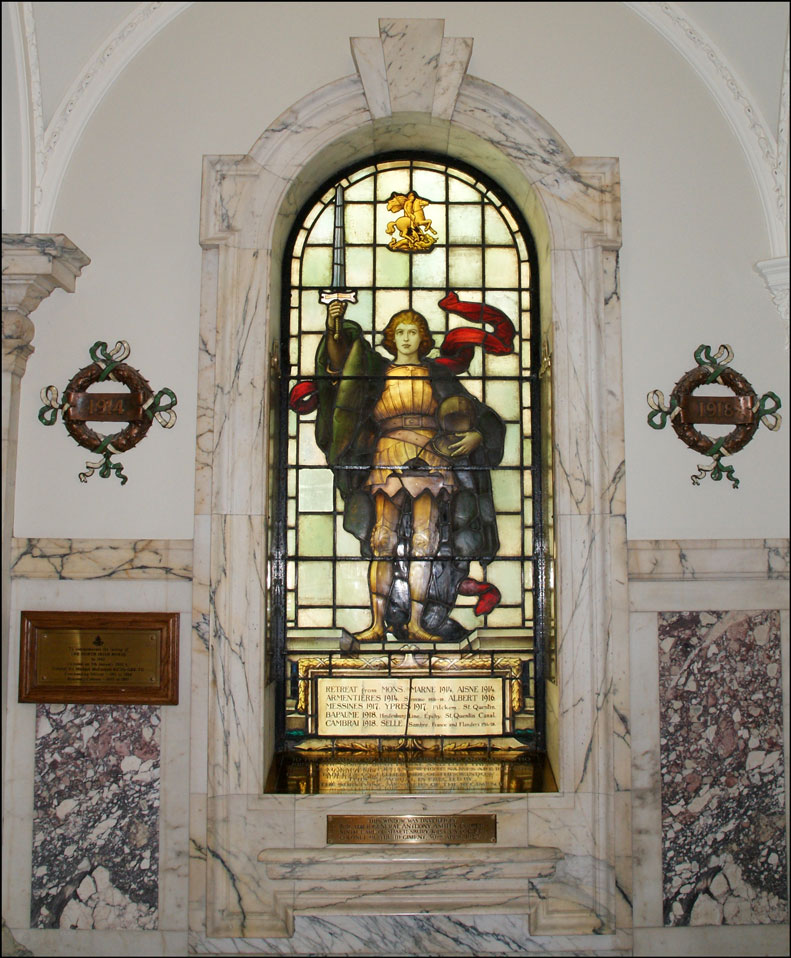
The names listed on the plaques are:
Lieutenant Colonel R.A West VC; Major Holt Waring; Captains D McCausland, S.T Saunderson, E Sinton MC, G.W Vesey MC; Lieutenants W Anderson, S.B Combe, J.R Dennistoun, J.K Greer MC, H.P Kellock, J Knox MC, A.W MacLaughlin, J.A MacLean MC, R.J McCullough, L.C Wise; 2nd Lieutenants R.H Andrews, J Denny, R.V Lyons, J.F.E McFarland, A McClelland, E.M Meredith, A Moore, H.P Nixon, W.L Reavie, R.C Russell, T Savage; Sergeants R Irwin, R.A Wylie; Lance Sergeant G.A Henry MM; Corporals W.H Adams, R.I Bradley, E Buchanan, T.J McCormick, D.W Ritchie; Lance Corporals J Deery, A Erskine, H Flanagan, R Hanna, R Hill, W Leckey, J McSparron, W.J Reid, T Stevenson, F Scanlon, S Turner; Troopers R.G Armstrong, W.F Arthur, J Baxter, W Beattie, J.A Bell, V Bell, J Best, W Biggart, A Blair, J Bowden, H Brennan, W Brown, T Bryson, T Cartmill, F.StG Cooke, F.T Cordwell, J Connell, A.S Crawford, J Cully, A Davey, J.J Durneen, W.H Dundas, C Elder, J Evans, J Forbes, J Forde, W Finlay, G Galbraith, J.N Gibson, G Gill, T.S Gillespie, M Haggan, N.H Hale, T Hall, G Harper, T Harper, T.M Henderson, R Heathwood, C Houston, R.J Hull, W Hillocks, A Huggins, W Irwin, A Johnston DCM, J Johnston, T Johnston, A.G Kelly, J Kelly, J.D King, A.J Knox, W.G Leinster, F Livingstone, T Lyons, J Magill, G Mark, A Martin, R.G.D Montgomery, J Moon, R Moore, A Morrison, W Morrow, H Mortimer, W Murphy, G.T Murray, J McArow, W.J McAuley, W McClelland, R McConnell, J.E McCready, C.H McDaniel, J McVea, M McVeigh, W Nixon, R O'Hara, R Park, A Pepper, W J Petty, R Richmond, J.E Riddle, J Roberts, S Robinson, R Ross, C Russell, H Scott, J Scott, G.M Shannon, S Shiels, P Sheridan, T Sittlington, J Sleator, J Smith, J Smyth, E Stevenson, G.W Stronge, W.P Stuart, J Talbot, F Tate, W Thompson, W.F Timbey, C.D Turner, C.R Woodside, T Wright, W Waller.
At the bottom on the window appears the Regiment's battle honours:
Retreat from Mons. Marne 1914. Aisne 1914. Armentieres 1914. Somme 1916-18. Albert 1916. Messines 1917. Ypres 1917. Pilckem. St Quentin. Bapaume 1918. Hindenburg Line. Epehy. St Quentin Canal. Cambrai 1918. Selle. Sambre. France and Flanders 1914-18.
In front of the window, a plaque reads:
TO THE MEMORY OF THE OFFICERS. NCOs., AND MEN WHO JOINED THE NORTH IRISH HORSE AND LOST THEIR LIVES IN THE GREAT WAR 1914-1918. AND WHOSE NAMES ARE RECORDED ON THE TABLETS ON EITHER SIDE OF THIS WINDOW. THIS MEMORIAL IS ERECTED BY THE SURVIVING MEMBERS OF THE REGIMENT
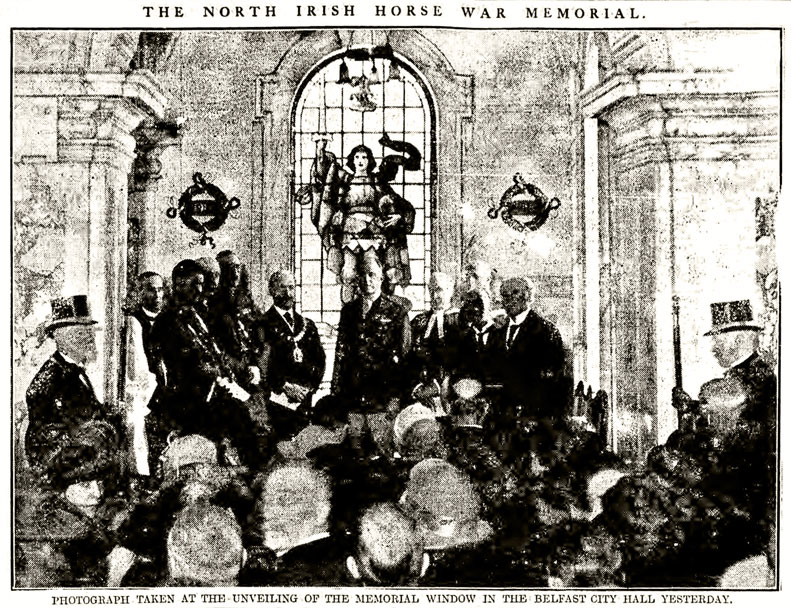
Belfast News-Letter, 1 May 1925
THE NORTH IRISH HORSE
MEMORIAL IN BELFAST.
Unveiling Ceremony by the Earl of Shaftesbury.
TRIBUTES TO THE FALLEN.
With becoming solemnity, the stained glass window, which has been placed in the east wall of the Belfast City Hall, in close proximity to the stately dome, as a memorial to the officers, non-commissioned officers and men of the North Irish Horse who fell in the great war, was unveiled yesterday afternoon by Brigadier-General the Earl of Shaftesbury, K.P., who asked the Lord Mayor to accept the window on behalf of the citizens.
The memorial is remarkable for its dignity and simplicity, as well as for the beauty of its composition and colour scheme. The design is dominated by the figure of a youthful warrior, clad in golden armour, with his right arm uplifted, holding a sword, and in his left hand a helmet. The figure is treated in a very effective manner against a severe plain background, and is brought out prominently by the rich colouring of the robes of green and ruby. Valour and fidelity are portrayed in the features of the warrior, who is seen standing on an ornamental base, in which a panel is arranged recording the military honours of the North Irish Horse, these including the Retreat from Mons, Marne, 1914; Aisne, 1914; Armentieres, 1914; Somme, 1916-1918; Albert, 1916; Messines, 1917; Ypres, 1917; Pilckem, St. Quentin, Bapaume, 1918; Hindenburg Line, Epehy, St. Quentin Canal, Cambrai, 1918; Selle, Sambre, France and Flanders, 1914-1918. In the circular head of the window there is the badge of St. George and the Dragon, as being the Patron Saint of Cavalry. On the sides of the window are two handsome polished bronze tablets, on which are engraved the names of the fallen. A sunk engraved broad plate on the sill of the window is inscribed as follows -- "To the memory of the officers, N.C.O.'s and men who joined the North Irish Horse, and lost their lives in the great war, 1914-1918, and whose names are recorded on the tablets on either side of this window. This memorial is erected by the surviving members of the regiment." On the wall, above the marble dado, two massive wreaths in cast bronze relief bear the dates 1914-1918. The memorial was designed and executed by Messrs. Ward & Partners, of Belfast, and has been carried out with great skill and taste.
Occupying seats on the dais were the Lord Mayor (Alderman Sir William Turner), the Earl of Shaftesbury, the Moderator of the General Assembly, Major-General Cameron, C.B., C.M.G.; Viscount Massereene and Ferrard, H.M.L.; the High Sheriff of Belfast (Councillor William Macartney, J.P.; the Chairman of the Improvement Committee (Alderman Barron, J.P.); the senior chaplain of the forces; Colonel Branscomb; Colonel Bramston-Newman, D.S.O.; the City Chamberlain (Sir Frederick Moneypenny, C.V.O.), and the A.D.C. to Major-General Cameron (Captain Cadogan). The officers of the regiment and the relatives of the deceased occupied seats in the first rows of chairs near the platform, whilst members of the Corporation sat to the immediate right of the platform. These included Councillor Sir William Coates, Bart., D.L., and Alderman Sir Crawford McCullagh (ex-Lord Mayors); and Alderman Mrs. McMordie, C.B.E. The Lady Mayoress was also present. Around the vestibule were bay trees at various points under the dome.
The proceedings were opened with the singing of the hymn "For all the Saints," the accompaniment being played by the band of the Royal Ulster Constabulary, conducted by Mr. George C. Ferguson. The singing was led by members of the Philharmonic Society.
LORD SHAFTESBURY.
Lord Shaftesbury said -- The memories of those four years, commonly known and talked of now as the period of the great war, will never fade from the minds of the present generation. To all of us the recollection of those years of national peril, the clash of arms, the clash of forces on land and sea and in the air, the struggle of right to triumph over wrong, and the fight for victory against the powers of tyranny and darkness, these things are still vivid and fresh in our memories. Nor can the sense of comradeship with the fallen, the weak, the crippled, and the disabled ever weaken or decay. Comradeship on the field of battle, in the face of a common danger and a common foe, welded men in bonds of steel that nothing -- neither time, space, nor distance -- can destroy. And so we love to mark our devotion to those who were left behind, those who went forth never to return, true and faithful to the last, surrendering all, even life itself, for King and Country. But we cannot think of them as dead, much less forgotten. No, rather may we picture them as alive, free from the fetters of this mortal world, and continuing to render fresh service in a world in which all is love and service. To-day we unveil this window to their memories -- memories that we love and cherish, honouring them in death as we honoured them in life. They were all brave and gallant men these North Irish Horsemen -- officers, non-commissioned officers, and men -- who went forth at the outbreak of war to take their place in the armies in France. I know something of the stuff of which they were made, for I had the privilege during some years of preparing and training them for the part which they were destined to play in the Great War, a part which they sustained unflinchingly to the last. We welcomed those who were privileged to return, and did them honour. To-day it is our fallen comrades who occupy the foremost place in our mind; to their relatives and their loved ones who gave them to their country we extend to-day, as at all times, the hand of sympathy and compassion. The window which I am now to unveil, forming as it does a part of this building, which in itself is a perpetual witness to the solidarity and the vigour of the people of Northern Ireland, will help to keep ever green in the minds and hearts of future generations of men and women the memories of those whom we honour in their deaths to-day, and may we not foretell that those future generations will, in their turn, be proud to claim them as a part of the old and common stock? I am privileged in being asked to unveil this window, and I do so in deep reverence to the memories which it enshrines.
His Lordship then drew aside the Union Jack by which the window had been covered, and the memorial was dedicated by the Moderator of the General Assembly, who said -- "We solemnly dedicate this window to the glory of God, and in grateful and affectionate remembrance of the gallant officers, non-commissioned officers, and men of the North Irish Horse who, in the Great War, laid down their lives in the cause of freedom and country and God. In the name of the Father, the Son, and the Holy Ghost. Amen."
The "Last Post" having been sounded by Mr. Horace Sewell, of the North Irish Horse, the Rev. E.F. Campbell, senior chaplain to the forces, Northern Ireland District, read prayers appropriate to the occasion.
Lord Shaftesbury then said -- It only remains for me, on behalf of the regiment, to thank you for having allowed us to place this memorial within the precincts of the City Hall; and may I say that if you, on behalf of the citizens of Belfast, are pleased to accept it, then we may be sure that it could not be in better or safer keeping.
THE LORD MAYOR.
The Lord Mayor said -- I feel that in placing this beautiful window in the City Hall to perpetuate the names, the gallantry, and the services of the officers and men of the North Irish Horse who gave their lives for their King and country in the Great War you have conferred a compliment on the citizens, and on their behalf I, as Lord Mayor, solemnly and gratefully accept the memorial as a sacred trust, to be preserved and tended with care by me and my successors in office. Just as the bright rays of the sun penetrate the window and diffuse warmth and radiance all around, so will the proud record of the valiant deeds performed by the men whose names are here inscribed shine in the annals of our city and province, and be to us and future generations an incentive to follow, at all times and under all circumstances, the path of honour and duty. The good citizen must be prepared to make sacrifices, and must place the interests of the community above his own. That is what our soldiers did in the war, and it is because of the spirit of loyalty and sacrifice which they displayed that we are here to-day to render homage to the memory of the officers and men of the North Irish Horse, whose bravery we reclaim with joy and pride, even while in all sincerity we mourn their death. On such occasion as this we cannot help recalling the glowing tribute which was paid to Ulster troops by his Majesty the King, whose words are well worthy of repetition -- "Throughout the long years of struggle, which have now so gloriously ended, the men of Ulster have proved how nobly they fight and die." I need not attempt to add anything to that eloquent and merited eulogy. I thank Lord Shaftesbury and the committee in charge of this memorial for placing it in the City Hall, and in the name of the citizens I assure them that it will always be regarded as one of our most cherished possessions.
Mr. Sewell then sounded "Reveille," the Moderator pronounced the benediction, and a very impressive service was brought to a close with the singing of the National Anthem.
Subsequently a wreath composed of laurel leave and poppies, and adorned with green and white ribbons, was placed on the ledge of the window, as a tribute from the regiment.
(Belfast News-Letter, 1 May 1925.)
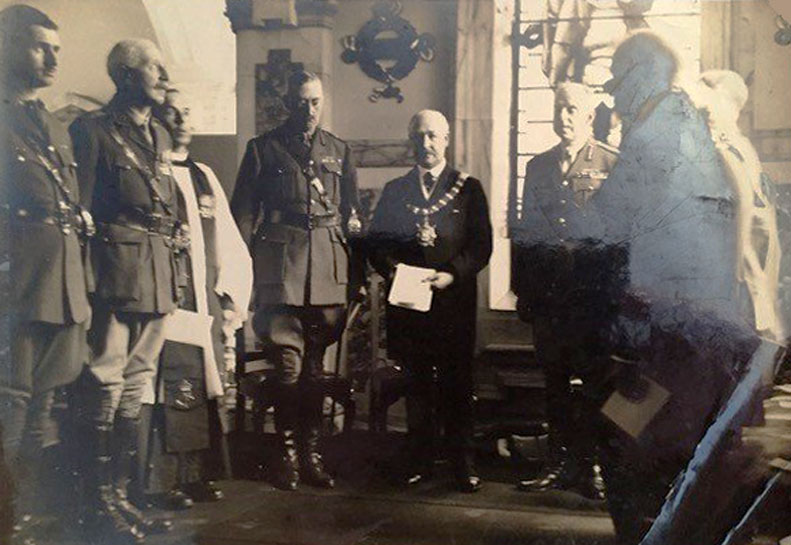
Image from the unveiling ceremony, 30 April 1925. Lord Shaftesbury is on the Lord Mayor's left.
Images 1, 3, 4 and 5 kindly provided by Robert Lindsay, image 6 by Nigel Henderson, and image 2 by Elizabeth Santillana Luna www.flickr.com/people/girlleastlikelyto. Image 8 sourced from the Great War Forum site, contributor 'Anneca'.

